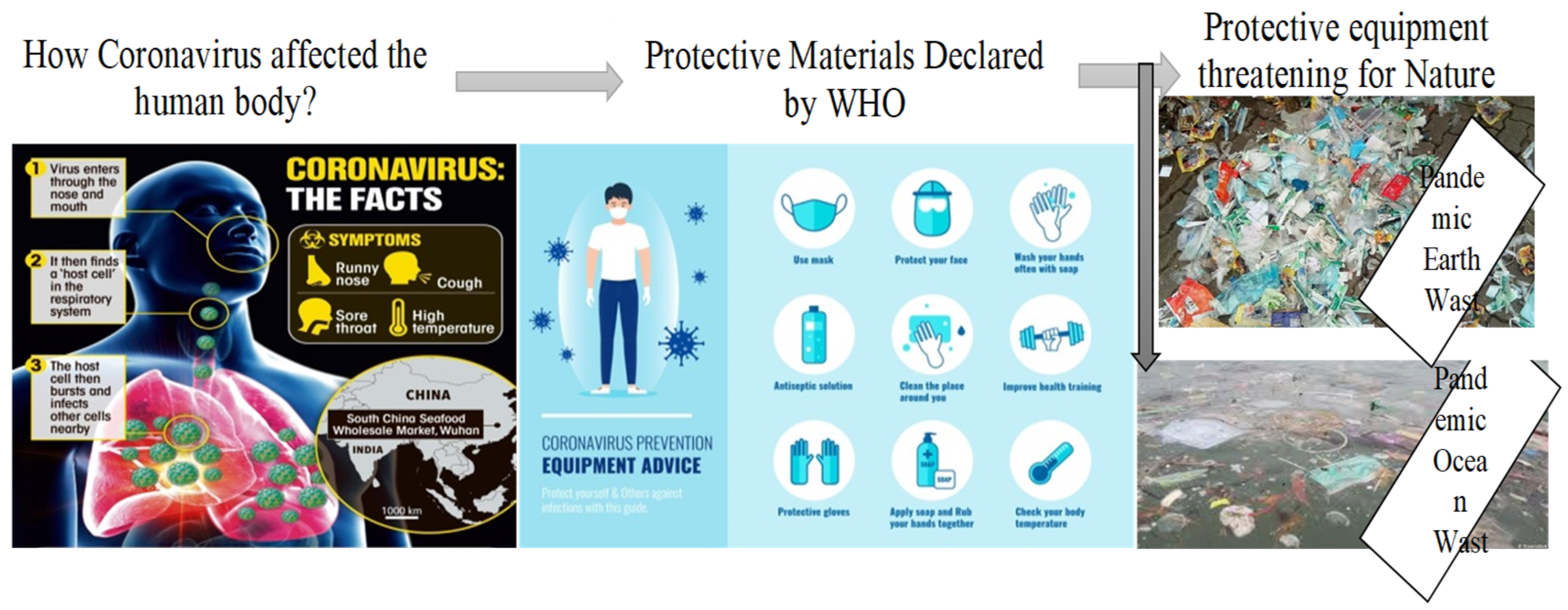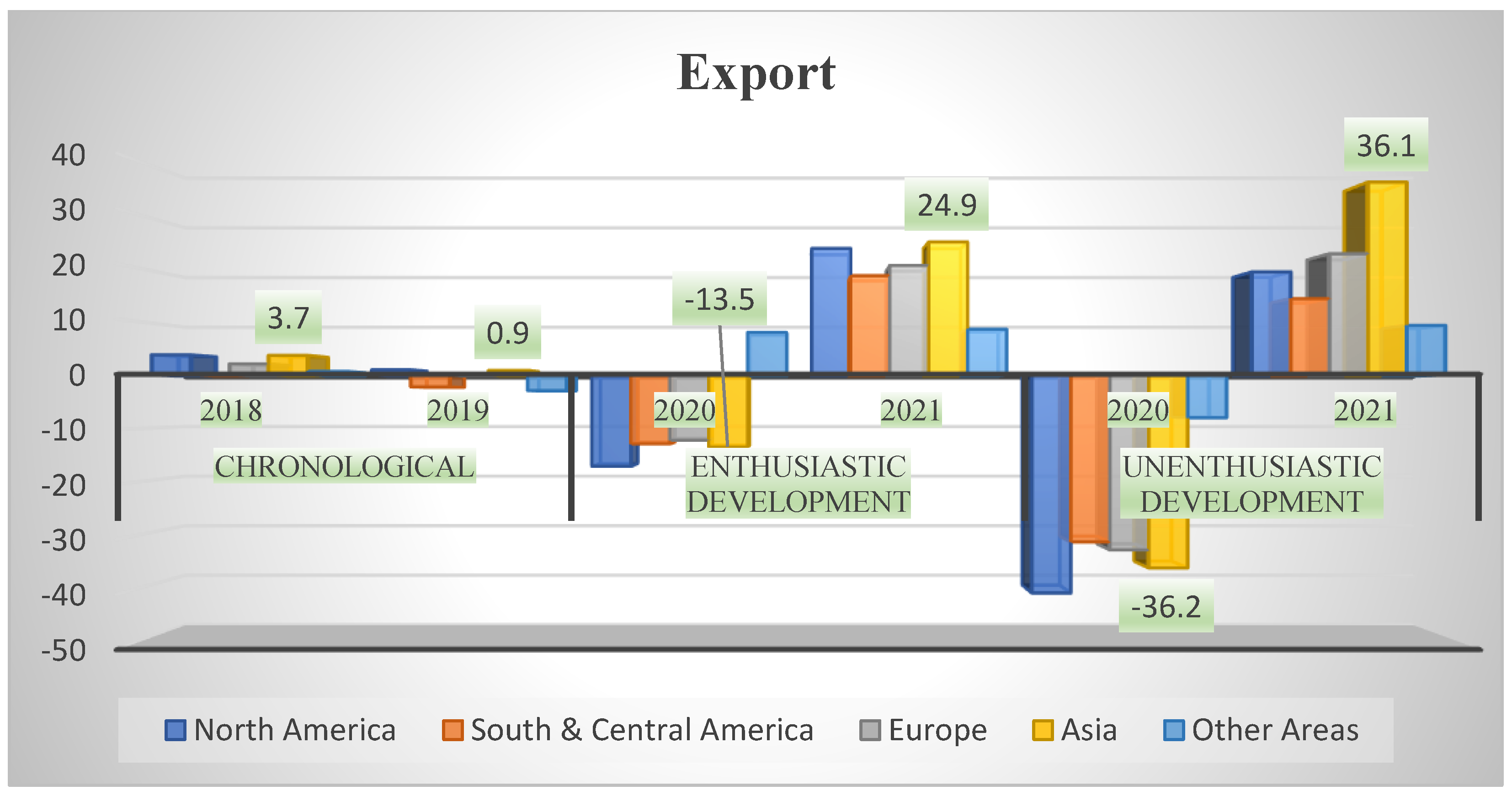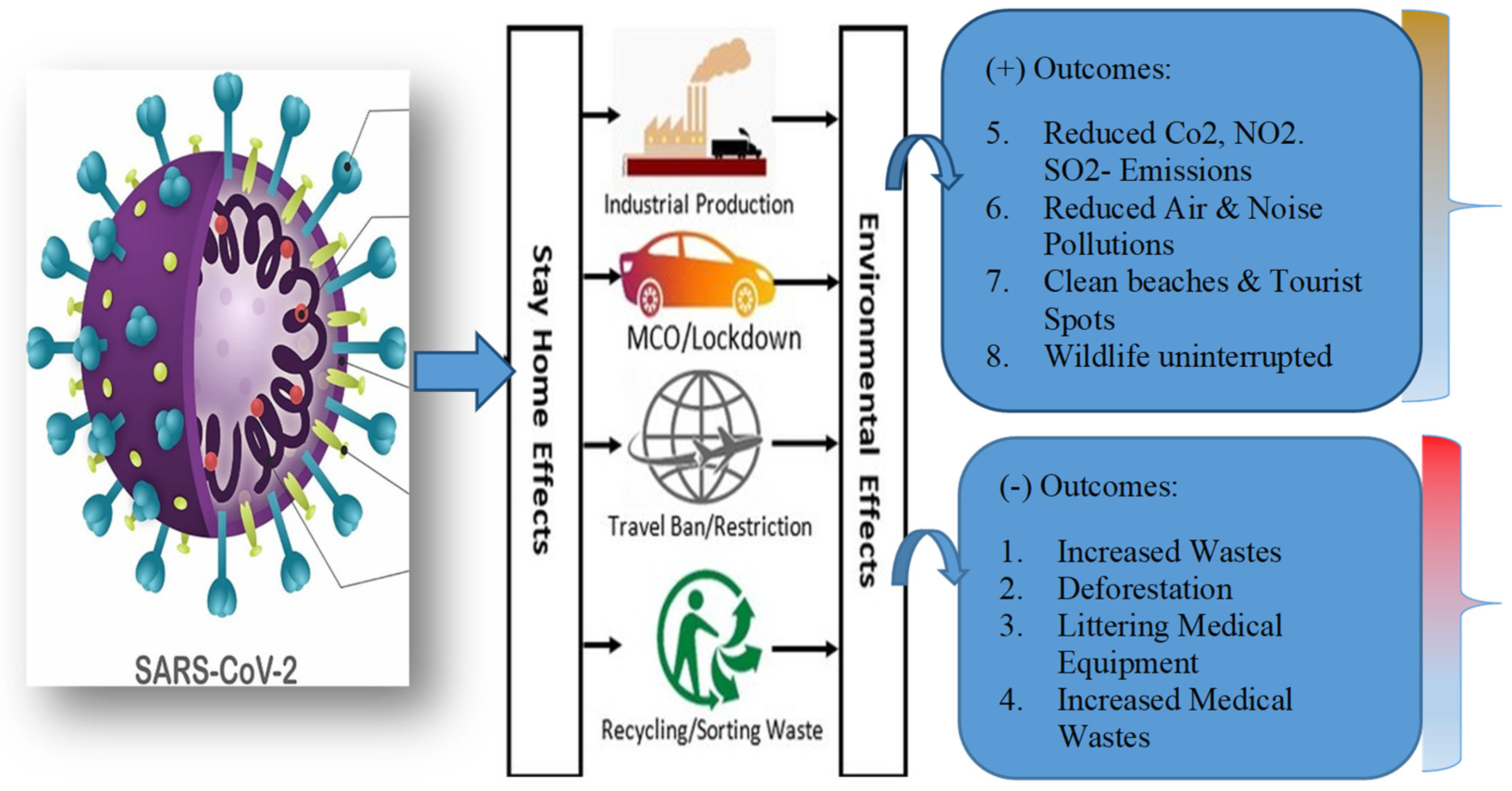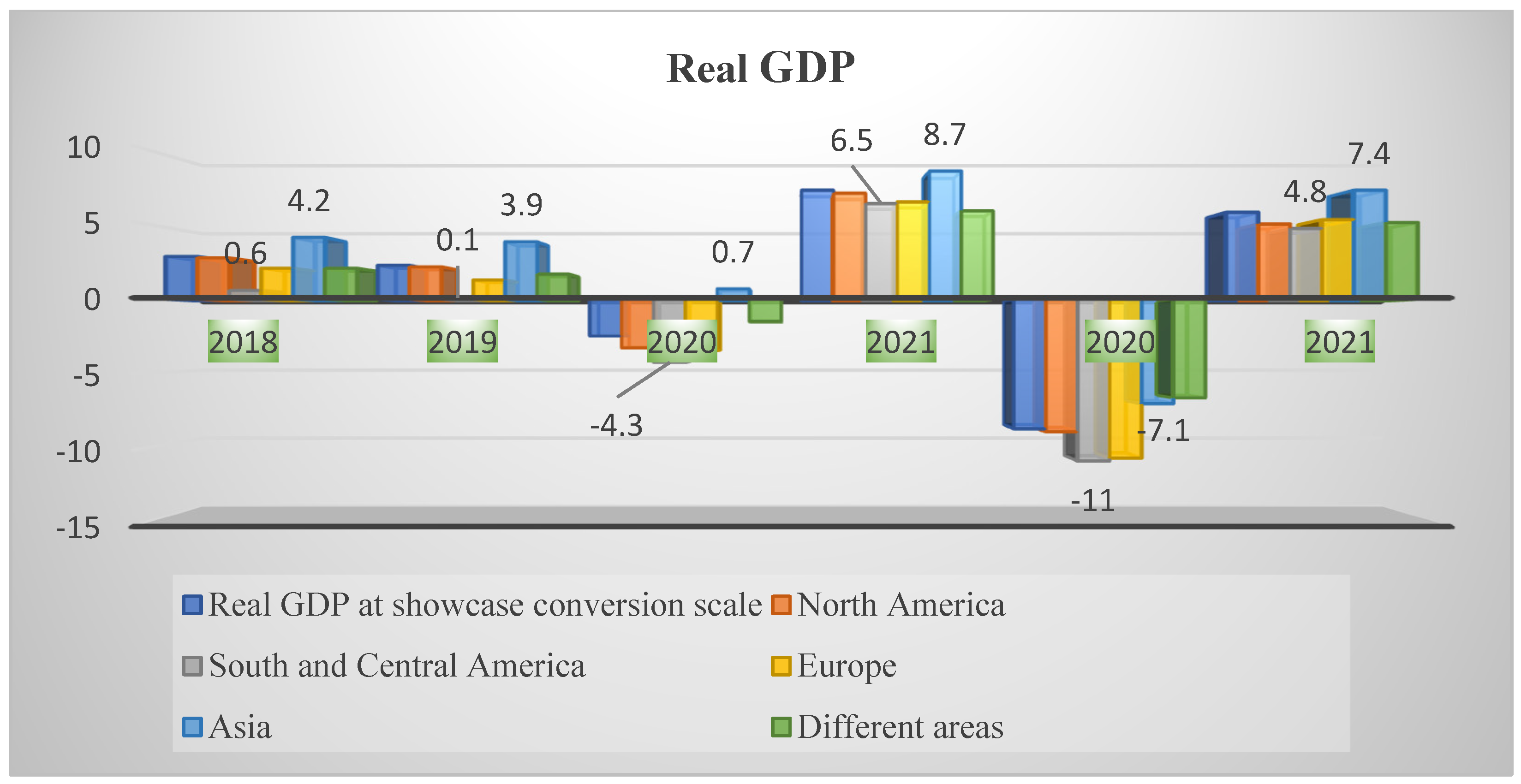The COVID-19 Pandemic: Are There Any Impacts on Sustainability?
Abstract
:1. Introduction
2. Materials and Methods
3. Discussions
3.1. COVID-19 Exacerbates Global Health and Alters the Environment Globally
3.2. Structural Alterations between COVID-19 and Global Environment
3.3. COVID-19’s Effects on Socio-Economy Groups and Sustainable Economy: How Are They Affected?
- Overpopulation and Family Size in Urban Areas:
- Does social distancing and self-isolation affect the socio-economy:
- The Transient Situations of the COVID-19 affecting the Sustainable Economy:
4. COVID-19 Influenced the Construction of a Green and Clean Environment
5. COVID-19 Regarding Global Anticipation, Sustainable Production, and Control Strategy
6. Fast Policy Response and Controlling Strategy
7. The Implication of the Findings
8. Conclusions and Suggestions
Author Contributions
Funding
Institutional Review Board Statement
Informed Consent Statement
Data Availability Statement
Conflicts of Interest
References
- World Health Organization (WHO). Coronavirus disease 2019 (COVID-19) Situation Report-38. 2019. Available online: https://www.who.int/docs/default-source/coronaviruse/situation-reports/20200227-sitrep-38-covid-19.pdf?sfvrsn=9f98940c_2 (accessed on 28 February 2020).
- Huang, C.; Wang, Y.; Li, X.; Ren, L.; Zhao, J.; Hu, Y.; Zhang, L.; Fan, G.; Xu, J.; Gu, X.; et al. Clinical features of patients infected with 2019 novel coronavirus in Wuhan, China. Lancet 2020, 395, 497–506. [Google Scholar] [CrossRef] [Green Version]
- Wang, C.; Horby, P.W.; Hayden, F.G.; Gao, G.F. A novel coronavirus outbreak of global health concern. Lancet 2020, 395, 470–473. [Google Scholar] [CrossRef] [Green Version]
- World Health Organization (WHO). Q&As on COVID-19 and Related Health Topics. 2020. Available online: https://www.who.int/emergencies/diseases/novel-coronavirus-2019/question-and-answers-hub (accessed on 26 May 2020).
- Worldometer, S. Covid-19 Coronavirus Pandemic: Worldometer. 2020. Available online: https://www.worldometers.info/coronavirus/ (accessed on 11 June 2021).
- CSSE. Coronavirus 2019-nCoV, CSSE. Coronavirus 2019-nCoVGlobal Cases by Johns Hopkins CSSE. 2019. Available online: https://gisanddata.maps.arcgis.com/apps/opsdashboard/index.html#/bda7594740fd40299423467b48e9ecf6 (accessed on 10 November 2020).
- Velavan, T.P.; Meyer, C.G. The COVID-19 epidemic. Trop. Med. Int. Health 2020, 25, 278. [Google Scholar] [CrossRef] [PubMed] [Green Version]
- Kooraki, S.; Hosseiny, M.; Myers, L.; Gholamrezanezhad, A. Coronavirus (COVID-19) outbreak: What the department of radiology should know. J. Am. Coll. Radiol. 2020, 17, 447–451. [Google Scholar] [CrossRef] [PubMed]
- Tyrrell, D.A.; Bynoe, M.L. Cultivation of viruses from a high proportion of patients with colds. Lancet 1966, 1, 76–77. [Google Scholar] [CrossRef]
- Ather, A.; Patel, B.; Ruparel, N.B.; Diogenes, A.; Hargreaves, K.M. Coronavirus disease 19 (COVID-19): Implications for clinical dental care. J. Endod. 2020, 46, 584–595. [Google Scholar] [CrossRef]
- Zhou, P.; Yang, X.L.; Wang, X.G.; Hu, B.; Zhang, L.; Zhang, W.; Si, H.R.; Zhu, Y.; Li, B.; Huang, C.L.; et al. A pneumonia outbreak associated with a new coronavirus of probable bat origin. Nature 2020, 579, 270–273. [Google Scholar] [CrossRef] [Green Version]
- Cao, Y.-C.; Deng, Q.-X.; Dai, S.-X. Remdesivir for severe acute respiratory syndrome coronavirus 2 causing COVID-19: An evaluation of the evidence. Travel Med. Infect. Dis. 2020, 35, 101647. [Google Scholar] [CrossRef]
- Kucharski, A.J.; Russell, T.W.; Diamond, C.; Liu, Y.; Edmunds, J.; Funk, S.; Eggo, R.M. Centre for Mathematical Modelling of Infectious Diseases COVID-19 working group. Early dynamics of transmission and control of COVID-19: A mathematical modelling study. Lancet Infect. Dis. 2020, 20, 553–558. [Google Scholar] [CrossRef] [Green Version]
- Li, M.; Lei, P.; Zeng, B.; Li, Z.; Yu, P.; Fan, B.; Wang, C.; Li, Z.; Zhou, J.; Hu, S.; et al. Coronavirus disease (COVID-19): Spectrum of CT findings and temporal progression of the disease. Acad. Radiol. 2020, 27, 603–608. [Google Scholar] [CrossRef] [Green Version]
- Allocati, N.; Petrucci, A.; Di Giovanni, P.; Masulli, M.; Di Ilio, C.; De Laurenzi, V. Bat–man disease transmission: Zoonotic pathogens from wildlife reservoirs to human populations. Cell Death Discov. 2016, 2, 1–8. [Google Scholar] [CrossRef] [PubMed] [Green Version]
- Gorbalenya, A.E.; Baker, S.C.; Baric, R.; Groot, R.J.D.; Drosten, C.; Gulyaeva, A.A.; Haagmans, B.L.; Lauber, C.; Leontovich, A.M.; Neuman, B.W.; et al. severe acute respiratory syndrome-related coronavirus: The species and its viruses—A statement of the Coronavirus Study Group. BioRxiv 2020. [Google Scholar] [CrossRef]
- Pinheiro, M.D.; Luís, N.C. COVID-19 Could Leverage a Sustainable Built Environment. Sustainability 2020, 12, 5863. [Google Scholar] [CrossRef]
- Yu, Z.; Razzaq, A.; Rehman, A.; Shah, A.; Jameel, K.; Mor, R.S. Disruption in global supply chain and socio-economic shocks: A lesson from COVID-19 for sustainable production and consumption. Oper. Manag. Res. 2021, 1–16. [Google Scholar] [CrossRef]
- UNCTAD. The COVID-19 Shock to Developing Countries: Towards a “Whatever It Takes” Programme for the Two-Thirds of the World’s Population Being Left Behind. United Nations Conference on Trade and Development, March 2020. UNCTAD Geneva, Switzerland. Available online: https://unctad.org/system/files/official-document/gds_tdr2019_covid2_en.pdf (accessed on 4 December 2020).
- Van Bavel, J.J.; Baicker, K.; Boggio, P.S.; Capraro, V.; Cichocka, A.; Cikara, M.; Crockett, M.J.; Crum, A.J.; Douglas, K.M.; Druckman, J.N.; et al. Using social and behavioural science to support COVID-19 pandemic response. Nat. Hum. Behav. 2020, 4, 460–471. [Google Scholar] [CrossRef]
- Paital, B. Nurture to nature via COVID-19, a self-regenerating environmental strategy of environment in global context. Sci. Total Environ. 2020, 729, 139088. [Google Scholar] [CrossRef] [PubMed]
- Varona, L.; Gonzales, J.R. Dynamics of the impact of COVID-19 on the economic activity of Peru. PLoS ONE 2021, 16, e0244920. [Google Scholar] [CrossRef] [PubMed]
- Eichenbaum, M.S.; Rebelo, S.; Trabandt, M. The Macroeconomics of Testing and Quarantining; (No. w27104); National Bureau of Economic Research: Cambridge, MA, USA, 2020. [Google Scholar]
- Helm, D. The Environmental Impacts of the Coronavirus. Environ. Resour. Econ. 2020, 76, 21–38. [Google Scholar] [CrossRef]
- International Energy Agency. Oil Market Report. February 2020. Available online: https://www.iea.org/reports/oil-market-report-february-2020 (accessed on 4 June 2020).
- Klemeš, J.J.; Van Fan, Y.; Tan, R.R.; Jiang, P. Minimising the present and future plastic waste, energy and environmental footprints related to COVID-19. Renew. Sustain. Energy Rev. 2020, 127, 109883. [Google Scholar] [CrossRef]
- Nicola, M.; Alsafi, Z.; Sohrabi, C.; Kerwan, A.; Al-Jabir, A.; Iosifidis, C.; Agha, M.; Agha, R. The socio-economic implications of the coronavirus pandemic (COVID-19): A review. Int. J. Surg. 2020, 78, 185–193. [Google Scholar] [CrossRef]
- Yoo, J.-H. The Fight against the 2019-nCoV Outbreak: An Arduous March Has Just Begun. J. Korean Med Sci. 2020, 35, e56. [Google Scholar] [CrossRef] [PubMed]
- Web of Science (WoS). 2020. Available online: https://login.webofknowledge.com/ (accessed on 5 June 2020).
- Science Direct (SD). 2020. Available online: https://www.sciencedirect.com/ (accessed on 5 June 2020).
- Mossa-Basha, M.; Medverd, J.; Linnau, K.; Lynch, J.B.; Wener, M.H.; Kicska, G.; Sahani, D.J.R. Policies and guidelines for COVID-19 preparedness: Experiences from the University of Washington. Radiology 2020, 296, E26–E31. [Google Scholar] [CrossRef] [PubMed]
- Mitra, A.; Ray Chadhuri, T.; Mitra, A.; Pramanick, P.; Zaman, S. Impact of COVID-19 related shutdown on atmospheric carbon dioxide level in the city of Kolkata. Parana J. Sci. Educ. 2020, 6, 84–92. [Google Scholar]
- Jones, D.S. History in a Crisis—Lessons for Covid-19. N. Engl. J. Med. 2020, 382, 1681–1683. [Google Scholar] [CrossRef]
- Wilder-Smith, A.; Chiew, C.J.; Lee, V.J. Can we contain the COVID-19 outbreak with the same measures as for SARS? Lancet Infect. Dis. 2020, 20, e102–e107. [Google Scholar] [CrossRef] [Green Version]
- Wang, D.; Hu, B.; Hu, C.; Zhu, F.; Liu, X.; Zhang, J.; Wang, B.; Xiang, H.; Cheng, Z.; Xiong, Y.; et al. Clinical characteristics of 138 hospitalized patients with 2019 novel coronavirus–infected pneumonia in Wuhan, China. JAMA 2020, 323, 1061–1069. [Google Scholar] [CrossRef] [PubMed]
- Phan, L.T.; Nguyen, T.V.; Luong, Q.C.; Nguyen, T.V.; Nguyen, H.T.; Le, H.Q.; Nguyen, T.C.; Cao, T.M.; Pham, Q.D. Importation, and human-to-human transmission of a novel coronavirus in Vietnam. N. Engl. J. Med. 2020, 382, 872–874. [Google Scholar] [CrossRef] [PubMed] [Green Version]
- Riou, J.; Althaus, C.L. Pattern of early human-to-human transmission of Wuhan 2019 novel coronavirus (2019-nCoV), December 2019 to January 2020. Eurosurveillance 2020, 25, 2000058. [Google Scholar] [CrossRef] [PubMed]
- Backer, J.A.; Klinkenberg, D.; Wallinga, J.J.E. Incubation period of 2019 novel coronavirus (2019-nCoV) infections among travellers from Wuhan, China, 20–28 January 2020. Eurosurveillance 2020, 25, 2000062. [Google Scholar] [CrossRef] [Green Version]
- Jacobsen, K.H. Will COVID-19 generate global preparedness? Lancet 2020, 395, 1013–1014. [Google Scholar] [CrossRef]
- World Health Organization (WHO). WHO Coronavirus Disease (COVID-19) Dashboard. 2021. Available online: https://covid19.who.int/ (accessed on 9 October 2021).
- Phan, T.L.; Ching, C.T.S. A reusable mask for coronavirus disease 2019 (COVID-19). Arch. Med Res. 2020, 51, 455–457. [Google Scholar] [CrossRef] [PubMed]
- Hellewell, J.; Abbott, S.; Gimma, A.; Bosse, N.I.; Jarvis, C.I.; Russell, T.W.; Munday, J.D.; Kucharski, A.J.; Edmunds, W.J.; Funk, S.; et al. Feasibility of controlling COVID-19 outbreaks by isolation of cases and contacts. Lancet Glob. Health 2020, 8, e488–e496. [Google Scholar] [CrossRef] [Green Version]
- Rolain, J.-M.; Colson, P.; Raoult, D. Recycling of chloroquine and its hydroxyl analogue to face bacterial, fungal, and viral infections in the 21st century. Int. J. Antimicrob. Agents 2007, 30, 297–308. [Google Scholar] [CrossRef] [PubMed]
- Morse, J.S.; LaLonde, T.; Xu, S.; Liu, W.R. Learning from the Past: Possible Urgent Prevention and Treatment Options for Severe Acute Respiratory Infections Caused by 2019-nCoV. ChemBioChem 2020, 21, 730–738. [Google Scholar] [CrossRef]
- Lu, H. Drug treatment options for the 2019-new coronavirus (2019-nCoV). Biosci. Trends 2020, 14, 69–71. [Google Scholar] [CrossRef] [Green Version]
- Begum, H.; Alam, A.S.A.F.; Er, A.C.; Siwar, C.; Ishak, S. Economic Sustainability of Oil Palm Cultivation: Smallholder Perspective. Asian J. Poverty Stud. 2014, 1, 177–183. [Google Scholar] [CrossRef]
- Begum, H.; Choy, E.A.; Siwar, C.; Alam, F.; Ishak, S. Smallholder’s Practices towards Environment Sustainability. Adv. Sci. Lett. 2015, 21, 1742–1745. [Google Scholar] [CrossRef]
- Begum, H.; Siwar, C.; Er, A.C.; Alam, A.S.A.F. Environmentally Friendly Practices of Oil Palm Cultivators. Int. J. Adv. Appl. Sci. 2016, 3, 15–19. [Google Scholar]
- Alam, A.S.A.F.; Er, A.C.; Begum, H.; Siwar, C. Smallholders the Prominent Contributor in Oil Palm Sector for Sustainability. Int. J. Adv. Appl. Sci. 2016, 3, 20–24. [Google Scholar]
- Begum, H.; Siwar, C.; Alam, A.S.A.F.; Choy, E.A.; Ishak, S.; Alam, L. Enhancing Sustainability amongst Oil Palm Smallholders in Malaysia. Int. J. Agric. Resour. Gov. Ecol. 2018, 14, 62–79. [Google Scholar] [CrossRef]
- Bremer, S.; Schneider, P.; Glavovic, B. Climate change and amplified representations of natural hazards in institutional cultures. Nat. Hazard Sci. 2019, 13, 354. [Google Scholar]
- Masud, M.M.; Azam, M.N.; Mohiuddin, M.; Banna, H.; Akhtar, R.; Alam, A.S.A.F.; Begum, H. Adaptation Barriers and Strategies towards Climate Change: Challenges in the Agricultural Sector. J. Clean. Prod. 2017, 156, 698–706. [Google Scholar] [CrossRef]
- Coutts, A.; Beringer, J.; Tapper, N. Changing Urban Climate and CO2Emissions: Implications for the Development of Policies for Sustainable Cities. Urban Policy Res. 2010, 28, 27–47. [Google Scholar] [CrossRef]
- Rowan, N.J.; Galanakis, C.M. Unlocking challenges and opportunities presented by COVID-19 pandemic for cross-cutting disruption in agri-food and green deal innovations: Quo Vadis? Sci. Total Environ. 2020, 748, 141362. [Google Scholar] [CrossRef]
- Begum, H.; Alam, A.S.A.F.; Er, A.C.; Ghani, A.B.A. Environmental sustainability practices among palm oil millers. Clean Technol. Environ. Policy 2019, 21, 1979–1991. [Google Scholar] [CrossRef]
- Ozili, P.K.; Arun, T. Spillover of COVID-19: Impact on the Global Economy. Available at SSRN 3562570. 2020. Available online: https://ideas.repec.org/p/pra/mprapa/99317.html (accessed on 14 March 2020).
- Messner, W. The institutional and cultural context of cross-national variation in COVID-19 outbreaks. medRxiv 2020. [Google Scholar] [CrossRef] [Green Version]
- Ruscio, B.A.; Brubaker, M.; Glasser, J.; Hueston, W.; Hennessy, T.W. One Health—A strategy for resilience in a changing arctic. Int. J. Circumpolar Health 2015, 74, 27913. [Google Scholar] [CrossRef]
- Afelt, A.; Frutos, R.; Devaux, C. Bats, coronaviruses, and deforestation: Toward the emergence of novel infectious diseases? Front. Microbiol. 2018, 9, 702. [Google Scholar] [CrossRef] [PubMed] [Green Version]
- Olivero, J.; Fa, J.E.; Real, R.; Márquez, A.L.; Farfán, M.A.; Vargas, J.M.; Gaveau, D.; Salim, M.A.; Park, D.; Suter, J.; et al. Recent loss of closed forests is associated with Ebola virus disease outbreaks. Sci. Rep. 2017, 7, 1–9. [Google Scholar] [CrossRef] [Green Version]
- Godfray, H.C.J.; Aveyard, P.; Garnett, T.; Hall, J.W.; Key, T.J.; Lorimer, J.; Pierrehumbert, R.T.; Scarborough, P.; Springmann, M.; Jebb, S.A. Meat consumption, health, and the environment. Science 2018, 361, eaam5324. [Google Scholar] [CrossRef] [Green Version]
- Food and Agriculture Organization (FAO). 2007. Available online: https://www.fao.org/newsroom/en/news/2007/1000660/index.html (accessed on 12 April 2020).
- Salata, C.; Calistri, A.; Parolin, C.; Palù, G. Coronaviruses: A paradigm of new emerging zoonotic diseases. Pathog. Dis. 2020, 77, ftaa006. [Google Scholar] [CrossRef] [PubMed] [Green Version]
- Reyes, R.; Ahn, R.; Thurber, K.; Burke, T.F. Urbanization and Infectious Diseases: General Principles, Historical Perspectives, and Contemporary Challenges. In Challenges in Infectious Diseases. Emerging Infectious Diseases of the 21st Century; Fong, I., Ed.; Springer: Berlin/Heidelberg, Germany, 2013; pp. 123–146. ISBN 978-1-4614-4496-1. [Google Scholar]
- Honigsbaum, M. The Pandemic Century: One Hundred Years of Panic, Hysteria and Hubris; W. W. Norton & Company: New York, NY, USA, 2020. [Google Scholar]
- Lipsitch, M.; Swerdlow, D.L.; Finelli, L. Defining the epidemiology of Covid-19—Studies needed. N. Engl. J. Med. 2020, 382, 1194–1196. [Google Scholar] [CrossRef] [PubMed]
- Fang, L.; Karakiulakis, G.; Roth, M. Are patients with hypertension and diabetes mellitus at increased risk for COVID-19 infection? Lancet Respir. Med. 2020, 8, e21. [Google Scholar] [CrossRef]
- Giannis, D.; Ziogas, I.A.; Gianni, P. Coagulation disorders in coronavirus infected patients: COVID-19, SARS-CoV-1, MERS-CoV and lessons from the past. J. Clin. Virol. 2020, 127, 104362. [Google Scholar] [CrossRef]
- Zheng, Y.Y.; Ma, Y.T.; Zhang, J.Y.; Xie, X. COVID-19 and the cardiovascular system. Nat. Rev. Cardiol. 2020, 17, 259–260. [Google Scholar] [CrossRef] [Green Version]
- BBC News. Coronavirus: Pandemic Sends US Jobless Rate to 14.7%. Available online: https://www.bbc.com/news/business-52591262 (accessed on 8 May 2020).
- Rediff Realtime News. Prices of Agricultural Commodities Drop 20% Post COVID-19 Outbreak. Available online: https://realtime.rediff.com/news/india/Prices-of-agricultural-commodities-drop-20-post-COVID19outbreak/955078599584b749?src=interim_alsoreadimage (accessed on 20 March 2020).
- Anderson, R.M.; Heesterbeek, H.; Klinkenberg, D.; Hollingsworth, T.D. How will country-based mitigation measures influence the course of the COVID-19 epidemic? Lancet 2020, 395, 931–934. [Google Scholar] [CrossRef]
- Meo, S.A.; Al-Khlaiwi, T.; Usmani, A.M.; Meo, A.S.; Klonoff, D.C.; Hoang, T.D. Biological and epidemiological trends in the prevalence and mortality due to outbreaks of novel coronavirus COVID-19. J. King Saud Univ. Sci. 2020, 32, 2495–2499. [Google Scholar] [CrossRef]
- British Plastics Federation (BPF). COVID-19: Guidance & Legislation for the UK Plastics Industry. 2020. Available online: https://www.bpf.co.uk/recomed.aspx. (accessed on 11 June 2021).
- Chinazzi, M.; Davis, J.T.; Ajelli, M.; Gioannini, C.; Litvinova, M.; Merler, S.; Piontti, A.P.Y.; Mu, K.; Rossi, L.; Sun, K.; et al. The effect of travel restrictions on the spread of the 2019 novel coronavirus (COVID-19) outbreak. Science 2020, 368, 395–400. [Google Scholar] [CrossRef] [Green Version]
- Bai, Y.; Yao, L.; Wei, T.; Tian, F.; Jin, D.Y.; Chen, L.; Wang, M. Presumed asymptomatic carrier transmission of COVID-19. JAMA 2020, 323, 1406–1407. [Google Scholar] [CrossRef] [Green Version]
- Hemida, M.G.; Abduallah, M.M.B. The SARS-CoV-2 outbreak from a one health perspective. One Health 2020, 10, 100127. [Google Scholar] [CrossRef]
- IMF. International Monetary Fund, World Economic Outlook, April 2021. Latest World Economic Outlook Growth Projections. Available online: https://www.imf.org/en/Publications/WEO/Issues/2021/03/23/world-economic-outlook-april-2021 (accessed on 11 June 2021).
- Zambrano-Monserrate, M.A.; Ruano, M.A.; Sanchez-Alcalde, L. Indirect effects of COVID-19 on the environment. Sci. Total Environ. 2020, 728, 138813. [Google Scholar]
- Baldwin, R.; Tomiura, E. Thinking ahead about the trade impact of COVID-19. In Economics in the Time of COVID-19; CEPR Press, Centre for Economic Policy Research: London, UK, 2020; Volume 59. [Google Scholar]
- Harapan, H.; Itoh, N.; Yufika, A.; Winardi, W.; Keam, S.; Te, H.; Megawati, D.; Hayati, Z.; Wagner, A.L.; Mudatsir, M. Coronavirus disease 2019 (COVID-19): A literature review. J. Infect. Public Health 2020, 13, 667–673. [Google Scholar] [CrossRef] [PubMed]
- Ficetola, G.F.; Rubolini, D. Climate affects global patterns of COVID-19 early outbreak dynamics. medRxiv 2020. [Google Scholar] [CrossRef] [Green Version]
- ESA. COVID-19: Nitrogen Dioxide over China. 2020. Available online: https://www.esa.int/Applications/Observing_the_Earth/Copernicus/Sentinel-5P/COVID-19_nitrogen_dioxide_over_China (accessed on 4 April 2020).
- ESA. 2020. Available online: https://www.esa.int/Applications/Observing_the_Earth/Copernicus/Sentinel-5P/Coronavirus_lockdown_leading_to_drop_in_pollution_across_Europe (accessed on 4 April 2020).
- Sharma, P.; Dhar, A. Effect of hydrogen supplementation on engine performance and emissions. Int. J. Hydrog. Energy 2018, 43, 7570–7580. [Google Scholar] [CrossRef]
- McCloskey, B.; Heymann, D.L. SARS to novel coronavirus–old lessons and new lessons. Epidemiol. Infect. 2020, 148, e22. [Google Scholar] [CrossRef] [Green Version]
- Lau, H.; Khosrawipour, V.; Kocbach, P.; Mikolajczyk, A.; Schubert, J.; Bania, J.; Khosrawipour, T. The positive impact of lockdown in Wuhan on containing the COVID-19 outbreak in China. J. Travel Med. 2020, 27, taaa037. [Google Scholar] [CrossRef] [Green Version]
- American Veterinary Medical Association. COVID-19. Available online: https://www.avma.org/resources-tools/animal-health-and-welfare/covid-19 (accessed on 20 March 2020).
- BASF Frets|IndustryWeek COVID-19 Is Coming for the Chemical Industry in 2020. 2020. Available online: https://www.industryweek.com/supply-chain/planningforecasting/article/21125045/covid19-is-coming-for-the-chemical-industry-in-2020-basf-frets (accessed on 9 May 2020).
- Reuters. OPEC’s Pact with Russia Falls Apart, Sending Oil into Tailspin. Mar 6. 2020. Available online: https://www.reuters.com/article/us-opec-meeting-idUSKBN20T0Y2 (accessed on 23 March 2020).
- The Guardian. MPs in Plea to Government over UK’s Covid-19 Stockpiling. 2020. Available online: https://www.theguardian.com/world/2020/mar/21/mps-plea-government-uk-covid-19-stockpiling-coronavirus (accessed on 23 March 2020).
- Jack, S. BBC News; What Are Shops Doing about Stockpiling? 22 March 2020. Available online: https://www.bbc.com/news/business-51737030 (accessed on 23 March 2020).
- Jack, S. BBC News; Online Shopping Website Ocado Suspends Service. 18 March 2020. Available online: https://www.bbc.com/news/business-5194198 (accessed on 23 March 2020).
- BBC News. Stockpiling ‘Will Hit Vulnerable’, Food Bank Warns. 13 March 2020. Available online: https://www.bbc.com/news/uk-england-beds-bucks-herts-51856592 (accessed on 23 March 2020).
- BBC News. Food Bank Shortage Blamed on Coronavirus Panic. 13 March 2020. Available online: https://www.bbc.com/news/uk-england-london-51837892 (accessed on 23 March 2020).
- Calma, J. 2020. Available online: https://www.theverge.com/2020/3/26/21194647/the-covid-19-pandemic-is-generating-tons-of-medical-waste (accessed on 5 April 2020).
- Varotto, A.; Spagnolli, A. Psychological strategies to promote household recycling. A systematic review with meta-analysis of validated field interventions. J. Environ. Psychol. 2017, 51, 168–188. [Google Scholar] [CrossRef]
- Ma, B.; Li, X.; Jiang, Z.; Jiang, J. Recycle more, waste more? When recycling efforts increase resource consumption. J. Clean. Prod. 2019, 206, 870–877. [Google Scholar] [CrossRef]
- Bir, B. Single-Use Items Not Safest Option Amid COVID-19. 2020. Available online: https://www.aa.com.tr/en/health/single-use-items-not-safest-option-amidcovid-19/1787067 (accessed on 5 April 2020).
- Rothan, H.A.; Byrareddy, S.N. The epidemiology and pathogenesis of coronavirus disease (COVID-19) outbreak. J. Autoimmun. 2020, 109, 102433. [Google Scholar] [CrossRef]



| Secondary Research Questions | Main Methodological Steps | Table/ Graphs |
|---|---|---|
| Do pandemics affect and alter the environment globally? What are the structural alterations between COVID-19 and the environment? How are socio-economic groups affected? Could COVID-19 impact help build a sustainable environment? What are the potential controllable measures and strategies that can help to increase sustainable global production? | 3.1 COVID-19 exacerbates global health with critical events. 3.2 Structural alterations between COVID-19 and Global Environment | Figure 1 |
| 3.3 COVID-19’s effect on socio-economic groups and sustainable economy | Figure 2, Figure 3 and Figure 4 | |
| 4. COVID-19’s Influence to build a Green and Clean Environment | Figure 5 | |
| 5. COVID-19 as Global anticipation, sustainable production, controller Strategy. 6. Fast Policy Response and Controlling Strategy | ||
| Research objectives | What are the potential global impacts on the environment due to COVID-19? What controllable strategies or anticipations emerge from rethinking sustainable production? | |
Publisher’s Note: MDPI stays neutral with regard to jurisdictional claims in published maps and institutional affiliations. |
© 2021 by the authors. Licensee MDPI, Basel, Switzerland. This article is an open access article distributed under the terms and conditions of the Creative Commons Attribution (CC BY) license (https://creativecommons.org/licenses/by/4.0/).
Share and Cite
Begum, H.; Alam, A.S.A.F.; Leal Filho, W.; Awang, A.H.; Ghani, A.B.A. The COVID-19 Pandemic: Are There Any Impacts on Sustainability? Sustainability 2021, 13, 11956. https://doi.org/10.3390/su132111956
Begum H, Alam ASAF, Leal Filho W, Awang AH, Ghani ABA. The COVID-19 Pandemic: Are There Any Impacts on Sustainability? Sustainability. 2021; 13(21):11956. https://doi.org/10.3390/su132111956
Chicago/Turabian StyleBegum, Halima, A. S. A. Ferdous Alam, Walter Leal Filho, Abd Hair Awang, and Ahmad Bashawir Abdul Ghani. 2021. "The COVID-19 Pandemic: Are There Any Impacts on Sustainability?" Sustainability 13, no. 21: 11956. https://doi.org/10.3390/su132111956
APA StyleBegum, H., Alam, A. S. A. F., Leal Filho, W., Awang, A. H., & Ghani, A. B. A. (2021). The COVID-19 Pandemic: Are There Any Impacts on Sustainability? Sustainability, 13(21), 11956. https://doi.org/10.3390/su132111956











